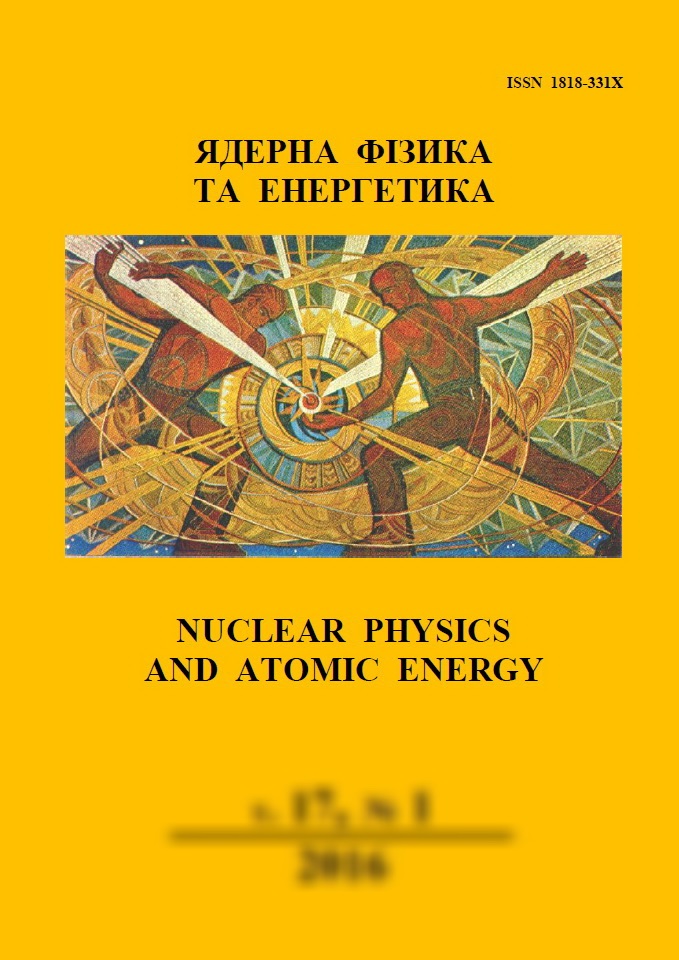 |
ßäåðíà ô³çèêà òà åíåðãåòèêà
Nuclear Physics and Atomic Energy
ISSN:
1818-331X (Print), 2074-0565 (Online)
Publisher:
Institute for Nuclear Research of the National Academy of Sciences of Ukraine
Languages:
Ukrainian, English, Russian
Periodicity:
4 times per year
Open access peer reviewed journal
|
Nucl. Phys. At. Energy 2019, volume 20, issue 1, pages 44-50.
Section: Radiobiology and Radioecology.
Received: 27.12.2018; Accepted: 17.04.2019; Published online: 26.06.2019.
 Full text (ua)
Full text (ua)
https://doi.org/10.15407/jnpae2019.01.044
Influence of radiation conditions of the Chernobyl Exclusion Zone on the hematopoietic system of bank vole
N. K. Rodionova, A. I. Lypska*, O. A. Sova, Î. O. Burdo, V. A. Shityuk, V. I. Nikolaev
Institute for Nuclear Research, National Academy of Sciences of Ukraine, Kyiv, Ukraine
*Corresponding author. E-mail address:
lypska@kinr.kiev.ua
Abstract:
Radiogenic changes in the blood system of Myodes glareolus inhabiting the sites of the 30-km ChNPP zone with different levels of radiation contamination were studied. It is shown that the chronic ionizing radiation exposure results in disorders in the animals' hemopoiesis. The imbalance in all blood cell lineages, especially erythroid one, was revealed. Animals inhabiting highly contaminated areas and exposed to the higher radiation doses had more steady changes in blood parameters, in particular their significant decrease. In all groups of the examined animals, in addition to radiation induced effects, compensatory repair processes were observed. They were manifested in the intensification of organism self-protection by activating the lymphoid components of immune system.
Keywords:
radionuclide contamination, chronic irradiation, bank vole, hematopoiesis system.
References:
1. Distant Environmental-Genetic Consequences of Radiation Incidents: Totsky Nuclear Explosion (Orenburg Region, 1954). Ed. A.G. Vasilyeva (Ekaterinburg, 2000) 288 p. (Rus)
2. V.I. Glazko, B.L. Zybaylov, T.T. Glazko. Increasing the level of ionizing radiation: “horizontal” and “vertical” biological and biosocial consequences (on examples of accidents at the Chernobyl Nuclear Power Plant and Fukushima-1 Nuclear Power Plant). Agricultural Biology 51 (2015) 141. (Rus)
https://doi.org/10.15389/agrobiology.2016.2.141rus
3. Radioecological studies in the Exclusion Zone of the Chernobyl NPP (to the 20-th anniversary of the accident at the Chernobyl NPP). Proc. of the Komi SC UB RAS 180 (2006) 232. (Rus)
4. Influence of the Radiation Factor of the Chornobyl Exclusion Zone on the Organism of Animals. Ed. Ya.I. Serkiz, M.Yu. Alesin (Kyiv: Atika, 2006) 320 p. (Ukr)
5. E.B. Grigorkina, G.V. Olenev, M.V. Modorov. Small mammals in the zone of the East Ural radioactive trace: 50 years later. Voprosy radiatsionnoy bezopasnosti. Special edition: East Ural radioactive trace - 50 years (2007) 68. (Rus)
6. Yoshihisa Kubota et al. Chromosomal Aberrations in Wild Mice Captured in Areas Differentially Contaminated by the Fukushima Dai-Ichi Nuclear Power Plant Accident. Environmental Science & Technology 49 (2015) 10074.
https://doi.org/10.1021/acs.est.5b01554
7. K.I. Maslova et al. Atlas of Pathological Changes in Vole-Housekeepers from Local Radioactive Contamination Foci (Moscow: Nauka, 1994) 187 p. (Rus)
8. E.A. Gilev. Ecological Genetic Monitoring with the Help of Rodents (Ural experience). (Ekaterinburg: Publishing House of the Ural University, 1996) 106 p. (Rus)
9. O.I. Kulygina. Hematological and Cytogenetic Consequences of the Chernobyl Accident for Three Types of Mouse-Like Rodents Living in the Exclusion Zone. Dissertation author's abstract (Moskva, 2001) 22 p. (Rus)
10. A.G. Kudyasheva et al. Monitoring populations of mouse rodents in conditions of elevated radiation background. Problemy bezpeky atomnykh elektrostantsiy i Chornobylya 3(2) (2005) 119. (Rus)
http://www.ispnpp.kiev.ua/wp-content/uploads/2017/2005_032/c119.pdf
11. I.A. Pashnina. Analysis of the Immunological and Hematological Characteristics of Rodents that Live in the Radioactive Environment. Dissertation author's abstract (Ekaterinburg, 2003) 17 p. (Rus)
12. O.O. Burdo et al. Influence of the radiation on cytogenetic parameters mouselike rodents from the Chornobyl Nuclear Power Plant exclusion zone. Yaderna Fizyka ta Energetyka (Nucl. Phys. At. Energy) 14(1) (2013) 69. (Ukr)
https://jnpae.kinr.kyiv.ua/14.1/Articles_PDF/jnpae-2013-14-0069-Burdo.pdf
13. N.I. Ryabokon et al. Long-term development of the radionuclide exposure of murine rodent populations in Belarus after the Chernobyl accident. Radiat. Environ. Biophys. 44 (2006) 169.
https://doi.org/10.1007/s00411-005-0015-2
14. C.A. Geraskin, S.V. Fesenko, R.M. Alexakhin. Impact of accidental discharge of ChAES on biota. Radiatsionnaya Biologiya. Radioyekologiya 46 (2006) 178. (Rus)
https://elibrary.ru/item.asp?id=9196351
15. Â.E. Rodgers, R.J. Baker. Frequencies of micronuclei in bank voles from zones of high radiation at Chornobyl, Ukraine. Environmental Toxicology and Chemistry 19 (2000) 1644.
https://doi.org/10.1002/etc.5620190623
16. S.N. Varshavskiy, K.T. Krylova. The basic principles for determining the age of mouse-like rodents. Bul. MOIP. New Ser. Otd. Biol. 17 (1948) 179. (Rus)
17. S.S. Schwartz, V.S. Smirnov, L.N. Dobrinsky. The Method of Morphophysiological Indicators in the Ecology of Terrestrial Vertebrates (Sverdlovsk: IEPR Proc., 1968) 387 p. (Rus)
18. O.S. Monastyrs’ka. Clinical Laboratory Studies. Ed. M.B. Shegedin (Vinnitsa: Nova Knyga, 2007) 165 p. (Ukr)
19. T.A. Moiseyeva. Indicators of white blood of red voles that live in the northern part of the Priladozhye. Uchenyye Zapiski Petrozavodskogo Gosudarstvennogo Universiteta 157 (2016) 76. (Rus)
http://uchzap.petrsu.ru/files/n157.pdf
20. D.Z. Shibkova, A.V. Akleyev. Adaptation-Compensatory Reactions of the Hematopoietic System under Chronic Radiation Exposure (Chelyabinsk: Publishing of ChGPU, 2006) 328 p. (Rus)
